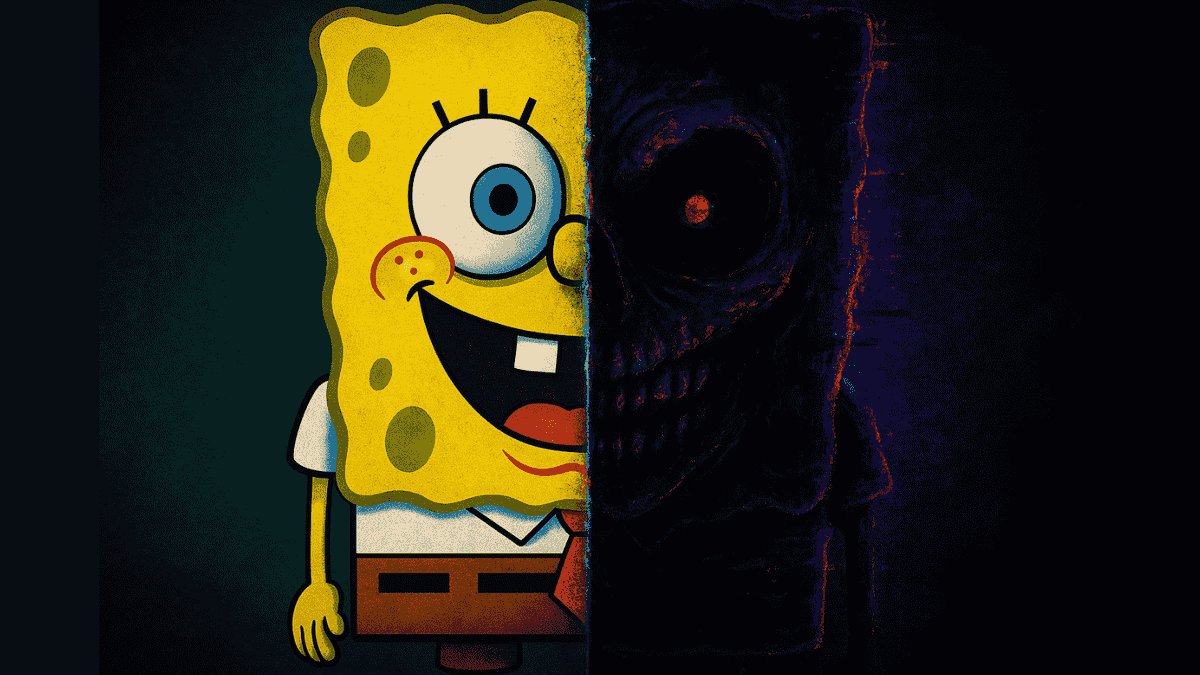1. From Krusty Krab to Internet Canon: The Rise of MemeBob
What began as a nautical nonsense cartoon for kids quietly slipped into internet immortality.
When SpongeBob SquarePants debuted in 1999, no one expected the show’s stills to one day become the internet’s favorite emotional shorthand. Over 20 years later, SpongeBob is less of a character and more of a digital dialect — embedded into online conversations across timelines and generations.
Other shows from the era faded into memory. SpongeBob didn’t fade — it transformed. Its elastic animation, absurdity without explanation, and characters who oscillated between cheerful and tragic made it the perfect specimen for meme mutation.
From MySpace status updates to TikTok edits, SpongeBob content has outlived platforms. This isn’t just a story of a cartoon going viral. It’s a case study in how a children’s show rewired itself into the very fabric of meme communication.

2. Built for the Internet: Why SpongeBob Was Meme Material from Day One
SpongeBob wasn’t designed to be a meme. But it might as well have been.
Its visual exaggeration is unmatched. Frames bounce between hyper-emotive and hilariously grotesque. Characters go from joy to breakdown in the blink of a frame — and those transitions? Perfect for the internet’s love of out-of-context chaos.
Where most cartoons sought linear storytelling, SpongeBob thrived in tonal whiplash. One second you’re laughing; the next, you’re spiraling with Squidward. It’s that unpredictable rhythm that makes clips from the show feel right at home among the surrealist comedy and nihilistic humor of Gen Z feeds.
Each main character also functions as a walking template. Patrick channels impulsive idiocy. Squidward represents internalized dread. SpongeBob is blind hustle energy. Together, they make up the emotional Venn diagram of the online psyche.
This wasn’t accidental. It was just ahead of its time.
3. The Proto-Meme Years: SpongeBob’s Early Web Footprint (2000s–2010s)
Long before meme generators and trend maps, SpongeBob was already carving out space in the Wild West of early internet culture.
The first viral images weren’t polished — they were fuzzy screenshots slapped together with MS Paint fonts and no regard for aspect ratio. But they were funny. And they traveled. Forums like 4chan and SomethingAwful gave them life, and platforms like Tumblr and Facebook helped them multiply.
Let’s talk origin icons:
- “Ight, Imma Head Out” captured millennial detachment years before it had a name.
- “Is mayonnaise an instrument?” gave rise to anti-logic humor before absurdist replies became the norm.
- “Savage Patrick” predated the “villain era” meme trend, offering a face to unfiltered pettiness.
These weren’t memes built for scale. They were cultural artifacts passed among fans. No brand managers. No monetization. Just SpongeBob, pixelated and powerful.
And then came KnowYourMeme — a digital archive that didn’t just track the rise of these images but turned them into meme canon. SpongeBob was no longer fringe; he was folklore.
4. The Meme Renaissance: 2015–2020 and SpongeBob’s Peak Virality
If the early 2010s were SpongeBob’s warm-up, the second half of the decade was his world tour.
Between 2015 and 2020, the internet’s visual grammar evolved rapidly — and SpongeBob’s faces fit every template. His screengrabs weren’t just funny; they were communicative. Reaction images became reaction currencies. And few characters had more bankable expressions than those under the sea.
During this boom, memes became more abstract and more layered. A single SpongeBob frame could speak to irony, mental fatigue, political cynicism, or pure chaos — no caption required.
Let’s not forget:
- Mocking SpongeBob became a universal tool for dunking on bad takes.
- Handsome Squidward mutated from a one-off gag into the internet’s favorite parody of unrealistic beauty standards.
- The Imagination Rainbow? It evolved into a snarky way to dismiss dreams, influencers, or startup culture.
Reddit threads, stan Twitter, and even political accounts started using Bikini Bottom logic to make their point. The line between meme and message blurred — and SpongeBob was right in the middle of it.
5. From Stills to Soundtracks: SpongeBob’s TikTok Era
As the meme ecosystem shifted from static posts to dynamic clips, SpongeBob didn’t skip a beat — he hit record.
With the rise of TikTok, short-form video turned audio bites and rapid edits into the new meme currency. SpongeBob’s archives were rich with usable content: iconic laughs, confused muttering, unhinged screams — audio that doubled as emotional triggers and comedic punchlines.
Now, it wasn’t just about images. It was about remix culture. Suddenly, you’d see Squidward’s dance mashed up with drill beats or SpongeBob’s scream dropped into horror-core edits. Kids who weren’t even born when the show aired were using its voices to caption their day-to-day spiral.
Even on Discord, in Twitch chats, or deep in YouTube comments, SpongeBob evolved into shorthand — not as nostalgia, but as emotional infrastructure. SpongeBob had become fluent in the internet’s new dialect: motion, sound, and absurdism.
6. Emotional Echoes: Why SpongeBob Memes Cut Deep
SpongeBob memes aren’t just viral because they’re funny. They work because they strike nerves.
In a world where emotions are often ironized or hidden behind filters, SpongeBob characters offer the opposite: full-blown, unfiltered reactions. They over-express — and in doing so, capture exactly how we feel when words don’t cut it.
That’s why a sweaty SpongeBob feels like burnout. A blank-staring Squidward hits like existential dread. Patrick screaming into a void? It’s every Monday morning email notification rolled into one.
These characters have morphed from fictional figures into mood avatars. Not because they’re dramatic — but because they’re accurate.
Their humor isn’t lighthearted — it’s cathartic. SpongeBob memes say what we can’t, scream what we feel, and meme what we live.
7. Meme Architects: The Hidden Hands Behind the Sponge
The SpongeBob meme machine today is anything but accidental.
Behind every viral format is a team — or a bot — sculpting memes with algorithmic precision. Gone are the days of raw screenshots. Now, creators use editing software, AI prompts, and meme labs to engineer content that hits emotional peaks on cue.
Pages like @spongebobhub and anonymous meme creators on Reddit are building universes around old clips. AI bots remix lines, zoom into facial tics, and repurpose old episodes into trending sounds. These creators aren’t just mining nostalgia — they’re manufacturing formats.
And like digital folklore, each meme mutates as it travels. What starts as a reaction post might end as a Discord emoji, then reappear as a TikTok filter.
Sometimes, the original joke gets lost entirely — and that’s the point. SpongeBob is no longer defined by plot or episode. He’s a modular symbol — open source, open interpretation, infinitely remixable.
8. SpongeBob vs. FreakBob: The Surreal Meme Evolution
Some memes evolve. Others fracture. FreakBob was born from the latter.
While SpongeBob memes reflect the absurdity of childhood and early internet humor, FreakBob is their post-apocalyptic cousin — a grotesque remix born in the age of digital collapse. Where SpongeBob says, “Imagination!”, FreakBob whispers, “Corruption.”
This evolution isn’t accidental. It’s the byproduct of:
- Self-aware meme loops where users parody the parody
- Horror meme accounts remixing cheerful cartoon stills into unsettling edits
- A shift from relatable to surreal — where humor no longer needs punchlines, just vibes and dread
FreakBob thrives in comment sections, remix culture, and glitchcore — a domain where SFX screams and melting faces say more than words ever could. It’s no longer about “laughing at SpongeBob,” but laughing through him — as he mutates into something darker.
SpongeBob walked so FreakBob could glitch.
9. Conclusion: Will SpongeBob Ever Stop Mattering?
Cartoons come and go — but SpongeBob never leaves the meme chat.
Even as meme formats evolve faster than ever, SpongeBob holds a unique position. It’s not just nostalgia. It’s emotional durability. A single SpongeBob screenshot can still:
- Echo burnout culture
- Satirize politics
- Capture social anxiety better than a news article
Looking forward? Expect:
- AI-generated SpongeBob skits
- Deepfake mashups with horror undertones
- SpongeBob characters inserted into hyperreal TikToks or surreal edits
SpongeBob isn’t dying — it’s becoming post-organic. It exists now as language, template, and mirror. The cartoon stopped being just a show long ago.
It’s a meme operating system.
Frequently Asked Questions About SpongeBob Memes
1. What are the most famous SpongeBob memes?
The most iconic SpongeBob memes include:
- “Ight, Imma Head Out” – used to signal emotional exit or boredom.
- “Mocking SpongeBob” – the go-to image for sarcastic replies.
- “Savage Patrick” – the darkly confident side of everyone.
- “Tired SpongeBob” – a visual metaphor for burnout and exhaustion.
- “Imagination Rainbow” – now often used ironically to signal delusion or false hope.
These memes span from classic formats to modern-day adaptations across platforms.
2. Why is SpongeBob so memeable?
Because it was unintentionally designed for it. SpongeBob’s animation emphasizes exaggerated emotion, fast-paced absurdity, and timeless character dynamics. Combined, these make its frames easy to remix, caption, and reinterpret—turning stills into social commentary or pure chaos.
3. Where do SpongeBob memes come from?
Originally, SpongeBob memes circulated through:
- Forums like 4chan and Something Awful
- Early Facebook pages and Tumblr communities
Later, they gained traction on Reddit, then exploded on Twitter, TikTok, and Discord. Now, many originate from AI generators, meme artists, and remix culture that continuously evolves the formats.
4. Is SpongeBob meme culture dying?
Not at all. While formats change, SpongeBob is adapting, not fading. With tools like AI video editors, deepfakes, and meme remixes, SpongeBob memes are more fluid and creative than ever—shifting into surrealism, irony, and even existential dread. It’s not dying; it’s mutating.
5. Are SpongeBob memes copyrighted?
Yes, technically. All characters and visuals from SpongeBob are owned by Nickelodeon/Paramount. However, many memes fall under fair use because they’re:
- Transformative (adding new meaning)
- Non-commercial
- Used for satire or commentary
Still, it’s a legal gray area—especially if a meme goes viral or is used in monetized content.

Joseph Quinn is a writer and digital creator best known as the founder of FreakBobTime. With years of blogging experience, he blends technology, culture, and internet humor into unique stories and creative experiments. Through his work, Joseph brings back the playful, weird side of the web while making content that connects with readers worldwide.


8 thoughts on “The Rise of SpongeBob Memes: From TV to Internet Icon”